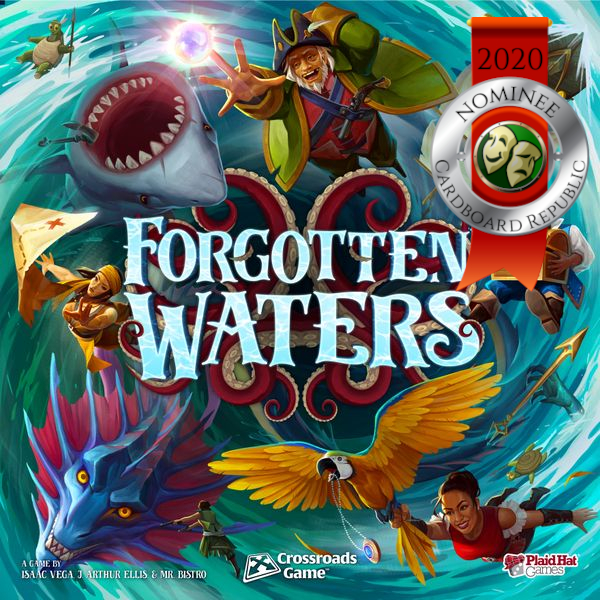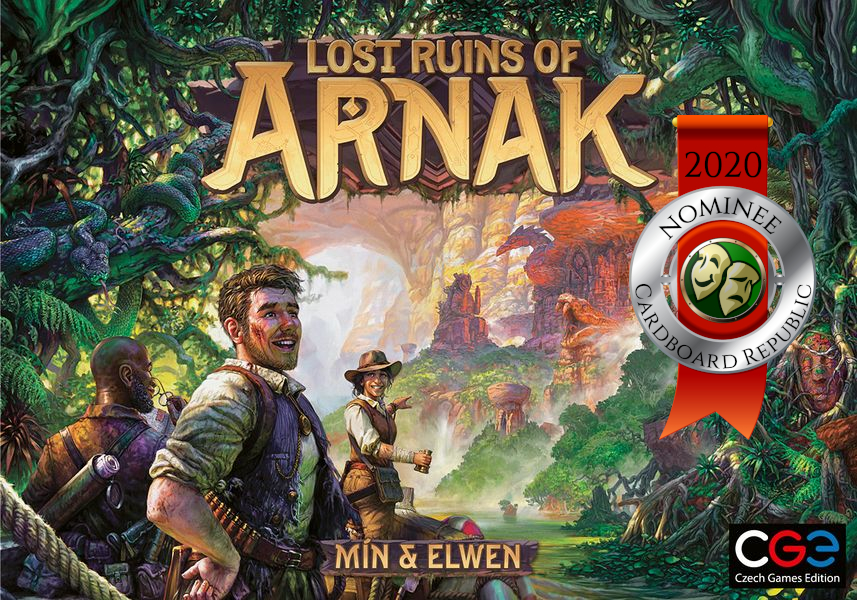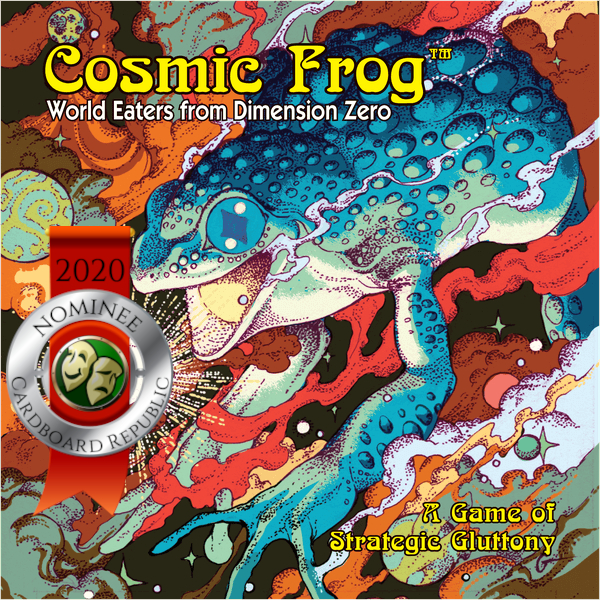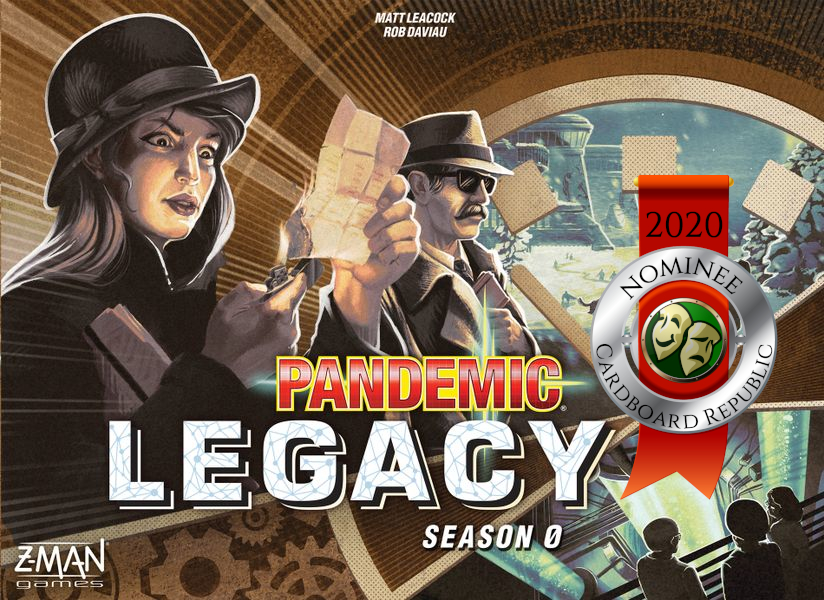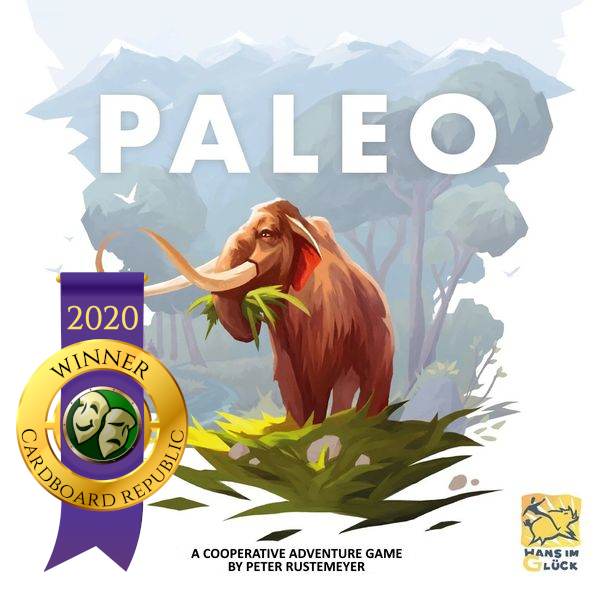The Cardboard Republic has rolled out the annual Laurels of the Republic awards, celebrating the best new games released in 2020 for each of the gamer archetypes. What follows are the finalists for one of those groups.
 From the depths of a cavernous dungeon, to the cold reaches of a distant conflict in outer space, to the exploration of the human condition, Immersionists thrive on a game’s locale. This group gets its biggest enjoyment out of games with rich settings that either tell some kind of story or serve some kind of purpose – games existing solely on basic mechanical or tactical choices are their kryptonite. Their driving interest revolves more around whether a particular mechanic or component fits whatever narrative is being told than if it’s the most ideal option. Immersionists want to be part of the game and feel as if their character belongs there. These roleplayers and worldbuilders demand that flavor actually matter to hold their interest – something more designers have been taking to heart in recent years.
From the depths of a cavernous dungeon, to the cold reaches of a distant conflict in outer space, to the exploration of the human condition, Immersionists thrive on a game’s locale. This group gets its biggest enjoyment out of games with rich settings that either tell some kind of story or serve some kind of purpose – games existing solely on basic mechanical or tactical choices are their kryptonite. Their driving interest revolves more around whether a particular mechanic or component fits whatever narrative is being told than if it’s the most ideal option. Immersionists want to be part of the game and feel as if their character belongs there. These roleplayers and worldbuilders demand that flavor actually matter to hold their interest – something more designers have been taking to heart in recent years.
And with that, here are The 2020 Laurel Finalists for Immersionists:
Honorable Mention: Pan Am
Publisher: Funko Games | Players: 2-4 | Play Time: 60 Minutes
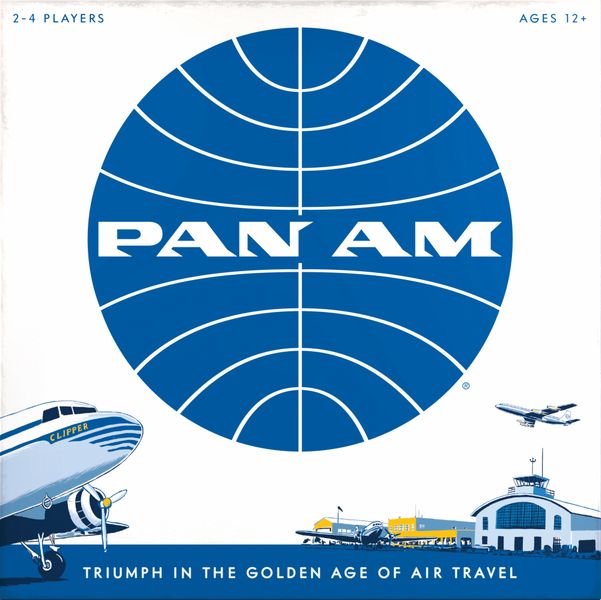
There is no magic formula to designing a thematic game. So long as you hold true to the philosophy that many gamers want meaningful purpose behind their in-game actions, and ideally, that those actions in turn make sense within the game’s premise, highly laudable, highly engaging thematic games can come from anyone.
That being said, just as there are some designers known for making deeply complex Euro games, so too are there those with a reputation for routinely creating rich, flavorful games. In recent years, the design team at Prospero Hall have been doing precisely that: showcasing their capabilities at making one praiseworthy lightweight thematic game after another. Pan Am is just the latest example.
Case in point: welcome to one of the most cohesively thematic games about the race to buy stock.
Starting off as a small regional airline, Pan Am expanded aggressively to become one of the premiere airlines in the world. For decades it was the gold standard for air travel both in its bevy of groundbreaking destinations and its insistence on flying in style. Demonstrating that evolution via a 30,000 foot view, players progress through several easily digestible rounds of worker placement and route building, all taking place over a roughly 40 year period.
The thing is, none of you actually work for Pan Am. They’re just your meal ticket.
Rather, each player is operating their own fledgling airline seeking to first compete with the soon-to-be behemoth and later to benefit from getting bought out by them. Each round has players scramble to buy up airports and airplanes to establish lucrative routes between cities. Then Pan Am expands, buying up those routes as it grows. How and where it expands is denoted by that round’s randomized but historically flavorful event card. Money is balanced between investing in furthering your own acquisitions and buying Pan Am stock – with the foresight that hey, this Miami-based carrier’s prospects may be on the rise.
Pan Am’s theme is subtler than some, but part of what makes it so laudable is how gracefully it interlaces its premise what in other hands would be a rather dry economic experience – which is no easy feat. That alone bears recognition.
Indeed, one of Pan Am’s last major slogans was “You Can’t Beat the Experience”. And for Immersionists, this concise, well-tailored game about ruling the skyways of the 20th century fittingly (albeit surprisingly) lives up to that claim.
The Nominees

Number Five: Forgotten Waters
Publisher: Plaid Hat Games | Players: 3-7 | Play Time: 120-240 Minutes
When it comes to designing pirate games, there are generally two paths. The first is a dark and gritty tale of survival, conquest, and danger. These lean into the slightly more real-world ethos that a pirate’s life is brutish, hard, and that conflict likely awaits you around every cove. The second is the more humorous and whimsical approach, akin to Monkey Island or Pirates of the Caribbean, where being a pirate isn’t exactly easy but it’s also not without a sense of wonder and excitement.
Just one look at the box tells you which direction Forgotten Waters is going, and it does so with unabashed enthusiasm.
On the calm, azure surface, Forgotten Waters is a mere blend of both of Plaid Hat’s well-known Crossroads event-based narrative system (i.e. Dead of Winter) as well as its AdventureBook series, wherein a spiral-bound book operates as the centerpiece to your current escapades. Its most innovative shift, however, rests with what isn’t there.
Yarr, the game’s event cards have been completely digitized, making Forgotten Waters the latest hybridization game. While some balk at the idea still, Forgotten Waters demonstrates that it can be done in a way that streamlines a game’s function without detracting from appreciably experiencing the world presented.
Yet for all these blended ideas, Forgotten Waters is remarkably easy to dive into. Which is good, because most pirates aren’t known for their nuance.
Here, players are all members of a hearty crew under an NPC captain looking to have one last grand adventure. In addition to individual goals of advancing skill growth and character story progression, each person is designated a ship role that monitors one of the numerous tracks throughout the game such as hull strength or crew happiness. Most rounds operate similarly, with each player placing their character on an action on the book’s page, resolving those actions via dice-based skill checks, and reading numbered events based on the various outcomes. Eventually, you either succeed at the scenario, or you meet a watery fate.
Though simple in execution, one doesn’t need to look too deep beneath the surface to understand the appeal of Forgotten Waters. Its heavy narrative focus is both engaging and exciting but never deviates into being farcical or heavy handed, resulting in an approachable, family-friendly swashbuckling co-op. To this group, who revere games of with extensive player-driven story elements, Forgotten Waters certainly charts the proper course.
Number Four: Lost Ruins of Arnak
Publisher: Czech Games Edition | Players: 1-4 | Play Time: 30-120 Minutes
For all the wondrous and imaginative settings, puzzles to navigate, and engaging interactivity board games provide, they are not without its limitations. When it comes to evoking or replicating certain situations, such as a cinematic car chase, board gaming is inescapably bound to its physical pieces and procedural pacing. This isn’t to say that capturing the essence of such ideas is impossible, and attempts are made on a regular basis, but there’s undeniably an added difficulty attached.
What can be surprising is that this includes games trying to encapsulate the surprise and excitement inherent to expeditions – when a party of individuals begins a journey into the unfamiliar, are met with surprises and setbacks, and may or may not ever reach their long-sought destination. RPGs can do this easily, and there’s no shortage of games with exploration as one of its tenants. But truly capturing that Homeric adventure-themed sensation is easier said than done.
Lost Ruins of Arnak is one of the best attempts at doing so in quite some time.
In this game, players are archaeologists who have discovered the island of a lost civilization, and the race is on to see whose efforts are the most successful. Through a tightly-knit combination of worker placement and deckbuilding mechanics, your intrepid explorers spend several rounds equipping themselves, unearthing new locations, discovering abandoned artifacts, and above all, building up enough research to possibly discover the location of the island’s Lost Temple itself.
The beauty to Arnak is twofold. For one, it’s no easy feat bringing that sense of the unknown to life through a turn-based structure. Yet thanks to its enthralling artwork, easy pacing, and an incentivization to continue pushing further into the uncharted island – both for thematic and victory reasons – Arnak succeeds at that meritorious task.
Moreover, Arnak makes careful effort to evoke the exploratory rush without veering into being exploitative. Your principal goal is to learn and investigate more than profit. Research has its own VP-granting track. There are no inhabitants to speak of save a handful of mysterious creatures – and even in those cases you fight but do not kill them. Such distinctions commendably add to Arnak’s thematic appeal by sidestepping several common miring adventure tropes.
The result of these decisions keeps the game energetic, upbeat, and with an eye eagerly on what’s over the next ridge – making Arnak one thematic expedition this group will gladly sign up for.
Number Three: Cosmic Frog
Publisher: Devious Weasel Games | Players: 2-6 | Play Time: 45-90 Minutes
For all the variety that exists in board gaming, it’s also hard to escape that there are certain themes which are so prevalent that a new game bearing it is met by some with a mix of exacerbation and eye-rolling. Even if they are ultimately enjoyable on other grounds, to those who put emphasis on theme as part of a game’s value on equal or even greater footing to mechanics – such as this group – there needs to be a particularly good reason to sit down to play another game about farming. Or medieval cities. Or farming near medieval cities. For those who relish being awash in a game’s setting, there’s an understandable predilection towards trying something a bit more original.
Consider, then, playing a game where you are frogs.
Except you are not normal frogs. You are frogs two miles tall. And your habitat isn’t some quaint vernal pool but space itself.
You are also immortal, practically indestructible, and powered by a tiny star.
And your sole purpose is to compete with other demigod-esque frogs to gobble up fragments of land from one area and spit them out in another.
That is Cosmic Frog.
In this game, a once thriving world shattered into pieces and was sent hurtling through space. The gods of that world’s inhabitants decided to stitch as much of it back together as they could (for Reasons), deploying their leggy servants to harvest salvageable parts for later reconstruction. The entire game takes place on one of these planetary shards.
Though proudly esoteric, gameplay in Cosmic Frog is relatively straightforward. Throughout each round every frog-god takes randomized turns hopping around to terrain tiles of different varieties, eating a couple, and then hopping back into the cosmic aether and depositing your spoils into your personal vault. How those tiles are deposited can aid you during the game but is also the sole way you score points to win.
Everyone else is trying to do the same thing, however, which leads to a lot of opportunistic shoving and jockeying for tiles, though Cosmic Frog shrewdly never devolves into a purely combat-driven exercise.
At its fiery core, Cosmic Frog is a competitive, slightly chaotic free-for-all race of acquisition. It just happens to be one of the strangest races you’ve ever seen. But for Immersionists, who thrive on well-implemented themes and creative ideas, Cosmic Frog is a pretty stellar experience.
Number Two: Pandemic Legacy: Season 0
Publisher: Z-Man Games / Asmodee North America | Players: 2-4 | Play Time: 45-60 Minutes
When the original Pandemic released in 2008, no one actively thought a captivating fast-paced, co-op about trying to eradicate rampaging viruses would go on to become a phenomenal worldwide success – going so far in many gamer’s minds as to be the quintessential embodiment of cooperative gameplay. But it did.
Likewise, with the idea of a legacy game still in its nascent stages, few thought in 2015 that taking the very same premise, throwing in an evolving series of permanent rule changes, and asking people to play that same game a dozen times or more in succession would catapult it to becoming (for a time) the number one rated hobbyist game. But it did.
So…is there anyone surprised that we are back here?
Yes, they’ve done it again. And yes, it’s just as deserving. In fact, in some ways it may be the best engineered iteration to date.
Though a wholly separate experience requiring no previous knowledge, PL:0 is nevertheless a narrative prequel to Pandemic Legacy Season 1. But because the events of Season 1 haven’t happened yet, in this version you must stop a plague of a different sort – COMMUNISM!
Pause for dramatic effect.
Set during the height of the Cold War, this time around players are medically trained CIA recruits tasked with stopping the development of a Soviet bioweapon. Fueled again by the legacy style gameplay approach, Season Zero’s efforts swap Pandemic’s medical motifs around disease discovery, treatment, and logistics for tracking down and flushing out Soviet spies infiltrating and causing mayhem in cities across the globe. Here, you and your team progress through a Cold War era campaign of intrigue, spycraft, and, well, a whole new slate of surprises you don’t have clearance for at the moment. All we can share is that though the basics will seem familiar, this is no mere reskin.
Like its predecessors, Pandemic Legacy is engrossing, challenging, and like the best legacy games tell an evolving story that you not only get to experience but have a driving hand in forging. Its level of flavor, theme, and engagement make you care about the outcome not just in terms of whether you win but learning what happens next with binge-like enthusiasm. To Immersionists, this is the kind of setting they can’t resist wanting to explore with rapacious curiosity – from the first dossier till the final shoe phone being dropped.
For a while we thought we were on track for another Pandemic Laurel winner, and may even would have until we came across another gripping Z-Man release that thrust us even further back in time…
The Winner
2020 Immersionist Laurel – Paleo
Publisher: Z-Man Games / Asmodee North America | Players: 1-4 | Play Time: 45-60 Minutes
We will be the first to admit: we did not see this one coming.
Going into the any annual preliminary vetting, we’re generally aware of and played many of the titles long before they end up making the final cut. Yet while we had pretty good foreknowledge about all the other games listed here today, Paleo was the one we had the least initial exposure to. Much of that was due to its late 2020 release, leading to a fairly short period of discovery. Late year releases can be a challenge to give them proper consideration under normal circumstances. But as we all undoubtedly know, the last couple months of 2020 wasn’t anything close to normal. By granting ourselves the additional lead time this year, we ensured certain releases weren’t overlooked.
Paleo is proof positive that decision was very, very much the correct one.
Set during the Upper Paleolithic stone age (albeit with some liberties to that end), Paleo gives each player control of a small band of hunter-gatherers with various skills. Rather than competing with one another though, your small band works in concert with the other players to form a tribe with a singular purpose: survive and flourish. For the alternative is death.
And you will see plenty of the latter. Much like the era in which it’s set, eking out a lasting existence is neither easy nor guaranteed. In this stone age simulation, the odds are definitely not in your favor, and outcomes are anything but predictable. That palpable sense of anxiety-inducing hardship resonates throughout the entire experience. It also gets you quickly invested in your collective fate.
Overarching game goals in Paleo are set by mixing pairs of 10 different modules, allowing for ample variation and replayability, but the overall flow generally remains the same. Each round players proceed through individual decks of cards that proffer possible team actions to take, resources to gain, and hazards to overcome. Risks must be taken to survive, but if too many of your tribe die due to injury or starvation – and they will – it’s game over. Only through working together and making decisions as a unified tribe can players defeat these daily travails and scrape out a victory.
Many games guide you through a story; Paleo demands that you live through it. With extensive modularity, highly unpredictable outcomes, and a heavy emphasis on flavorful team-based interaction, Paleo conjures a profoundly rewarding yet tension filled chronicle from sunup to sundown.
And is precisely for those reasons why Paleo speared this group’s Laurel.
![]()
Paleo Contest!
We thought about different ways to highlight how great the winning title of the Immersionist Laurel is. We tried to come up with some clever and thematic ideas, such as formulating a hunting band to go take down a wooly mammoth. However, we were forced to abandon that after one after the local museum told us to stop calling. We also got fairly far into planning a wilderness retreat, where we’d create a reality style competition of stranding players in the woods with little supplies or gear and asking them to survive solely on cooperation and guile. Alas, that one also fell apart when we misplaced our intern Claudius during the trial run for two months and since then we’d gotten a a steady dose from our lawyers on the innumerable ways we could get in legal or financial trouble if something like that happened to someone more important. And we really weren’t in the mood to shell out unnecessary expenses in 2021 unless it’s for a severely needed vacation. So in the end we opted for a simpler approach: providing one lucky winner with the opportunity to enjoy the award-winning game first hand. .
Note: In honor of their award recognition, Asmodee North America has kindly provided a copy of this game for giveaway purposes.
![]()
Be sure to check out the 2020 Laurel Award pages for the other archetypes once they go live!

